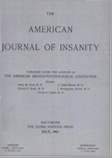Abstract
A comparative study of a group of EEGs of 126 schizophrenics and 81 manic-depressives revealed significant differences in the distribution of certain measurable factors. The distribution of the types of EEG pattern in the total psychotic group showed that 27 per cent had "A" types of pattern and 24 per cent had "MF" types. These percentages were lower than among "normals."
The "MF" and "B" types of patterns were almost equally distributed in the schizophrenics and included 50 per cent of the entire group. Since these two types of pattern have a fast frequency component in common which differentiates them from other types of patterns, they were combined as one for purposes of comparison. By contrast, 36 per cent of the manic-depressive group had "A" types of patterns which represented the largest number of any one type of EEG pattern.
The common baseline for alpha frequencies among "normals" is 10 to 10.5 cycles. Only 43 per cent of the total psychotic series had alpha frequencies in this range. Of the remainder 29 per cent of the schizophrenics had alphas slower than 10 cycles, and 32 per cent had alphas faster than 10.5 cycles. Of the manic-depressives outside the baseline alpha range, 32 per cent had slow alphas and only 15 per cent had fast alphas. Schizophrenics were found to have fewer EEGs with alphas of 10 to 10.5 cycles but twice the number of fast alphas, in contrast to the manic-depressives.
The findings suggest more cortical activity among the schizophrenics, as implied by the fast component and high percentage of "MF" and "B" types of patterns, than by the "A" type of patterns characteristics of the manic-depressive group. The synchronization of cortical activity, however, is clearer in the "A" type of pattern and it is the degree of synchronization of cortical activity in the EEGs which appears to differentiate the schizophrenics from the manic-depressives.
The presence of "choppy" activity(10), which is in a faster frequency range than the fast frequencies characteristic of the "MF" and "B" types of patterns, or fast alpha frequencies, was found in 61 per cent of the schizophrenics in contrast to 39 per cent of the manic-depressives. These findings are striking and significant since they are not related to type of pattern, alpha, or the factor of age. The "choppy" activity is regarded by the author as indicating, primarily, overstimulation or irritation of the cortex, which is due to unsynchronized activity within the central nervous system. This hypothesis is supported by animal experiments (1, 2, 3, 4, 12, 14, 15, 16). With this assumption, it might account for apparent early deterioration in schizophrenics as a secondary effect of prolonged or continuous overactivity. It was found to be present in 47 per cent of the schizophrenics and only 3 per cent of the manic-depressives under 40 years of age.
Comparison of the EEGs of old persons suffering from cerebral arteriosclerosis, and deteriorated schizophrenics under 40 years, showed that this "choppy" activity is not associated with old age nor cerebral arteriosclerosis.
Experiments with mescalin on "normal" individuals, by Sulzbach and the author, (not yet published) demonstrated the occurrence of the "choppy" activity with the appearance of schizophrenic-like symptoms. As the mescalin wore off both the "choppy" activity and the schizophrenic-like symptoms began to fade out at the same time, and the subject became normal again.
These findings give definite leads to a further understanding of schizophrenia and support the hypothesis that schizophrenia may be inherent, or recognized at an early age. The EEGs clearly demonstrate that the condition is primarily, not one of physiological sluggishness.

